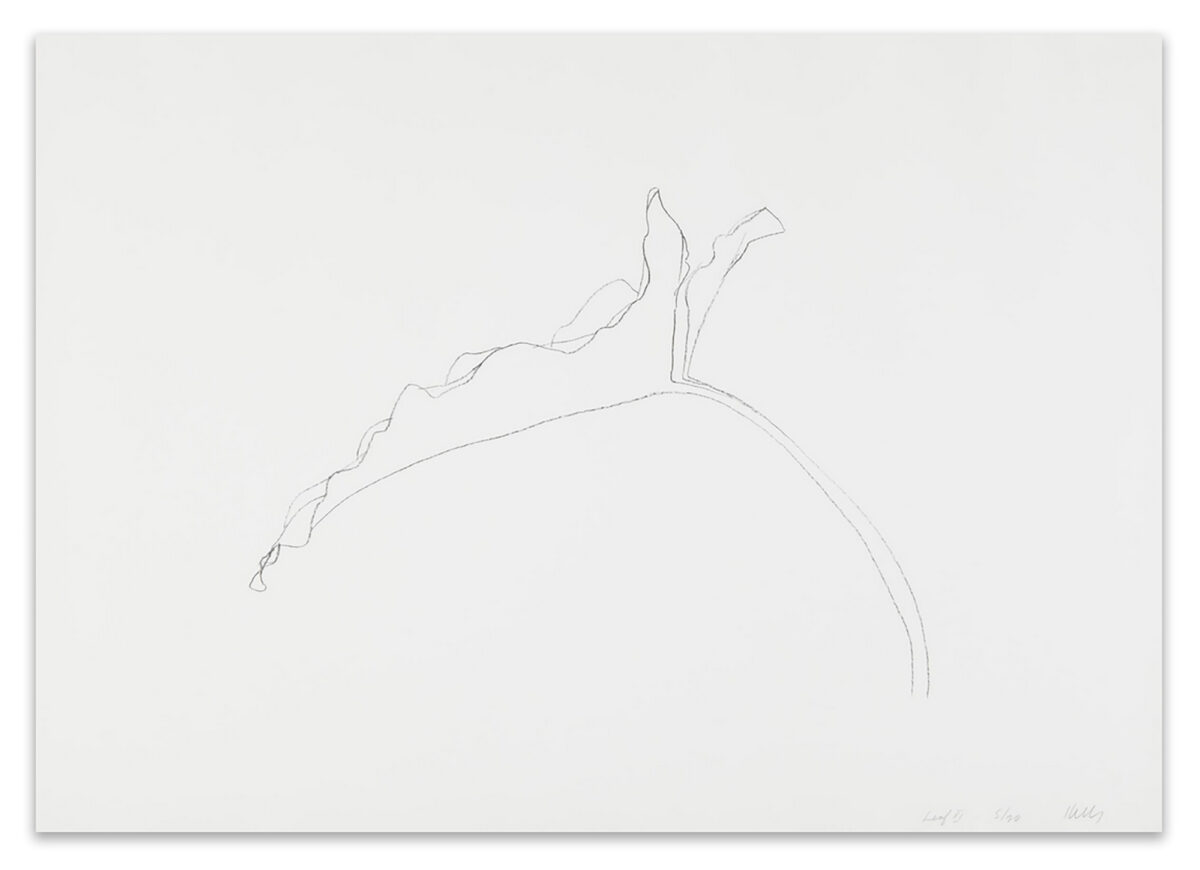
Edition of 20
Signed ‘Kelly’, numbered and dated lower right, in graphite
Image size: 19 x 25 inches (48.3 x 63.5 cm)
Paper size: 30 x 42 inches (76.2 x 106.7 cm)
Frame size: 35 1/4 x 47 3/4 inches (89.5 x 121.3 cm)
(Inventory #25314)
Edition of 20
Signed ‘Kelly’, numbered and dated lower right, in graphite
Image size: 19 x 25 inches (48.3 x 63.5 cm)
Paper size: 30 x 42 inches (76.2 x 106.7 cm)
Frame size: 35 1/4 x 47 3/4 inches (89.5 x 121.3 cm)
(Inventory #25314)
Ellsworth Kelly was born in 1923 in Newburgh, New York. He studied at Pratt Institute, Brooklyn, from 1941 to 1943. After military service from 1943 to 1945, he attended the School of the Museum of Fine Arts, Boston, from 1946 to 1948. In 1949, Kelly went to France and enrolled at the École des beaux-arts, Paris, under the GI Bill, although he attended classes infrequently. In France, he discovered Romanesque art and architecture as well as Byzantine art. He was also introduced to Surrealism and Neo-Plasticism, which led him to experiment with automatic drawing and geometric abstraction. In his work Kelly abstracts the forms in his paintings from observations of the real world, such as shadows cast by trees or the spaces between architectural elements.
In 1950, Kelly met Jean Arp and that same year began to make shaped-wood reliefs and collages in which elements were arranged according to the laws of chance. He soon began to make paintings in separate panels that could be recombined to produce alternate compositions, as well as multipanel paintings in which each canvas is painted a single color. During the 1950s, he traveled throughout France, where he met Constantin Brancusi, Alexander Calder, Alberto Magnelli, Francis Picabia, and Georges Vantongerloo, among other artists. His first solo show took place at the Galerie Arnaud Lefebvre, Paris, in 1951.
Kelly returned to the United States in 1954, living first in a studio apartment on Broad Street, New York, and then at Coenties Slip in lower Manhattan, where his neighbors would through the years include Robert Indiana, Agnes Martin, Fred Mitchell, James Rosenquist, Lenore Tawney, and Jack Youngerman. Kelly continued to develop and expand the vocabulary of painting, exploring issues of form and ground with his flatly painted canvases. His first solo show in New York was held at the Betty Parsons Gallery in 1956, and three years later he was included in 16 Americans at the Museum of Modern Art (MoMA), New York. In 1958, he also began to make freestanding sculptures. In 1959, art historian Jules Langsner termed the current of American geometric abstraction “Hard-edge painting,” connoting the shaped panels of bright color and rigid form created by Kelly and his contemporaries. Kelly moved out of Manhattan in 1970 and set up a studio in Chatham and a home in nearby Spencertown, New York, where he currently lives and works.
Kelly’s first retrospective was held at MoMA in 1973. The following year, he began an ongoing series of totemic sculptures in steel and aluminum. He traveled throughout Spain, Italy, and France in 1977, the same year that his work was included in Documenta in Kassel, West Germany. He has executed many public commissions, including a mural for UNESCO in Paris (1969), a sculpture for the city of Barcelona (1978), and a memorial for the United States Holocaust Memorial Museum, Washington, D.C. (1993). Kelly’s extensive work has been recognized in numerous retrospectives, including a sculpture exhibition at the Whitney Museum of American Art, New York (1982); an exhibition of works on paper and a show of his print works that traveled extensively in the United States and Canada (1987-88); and a career retrospective organized by the Guggenheim Museum (1996), which traveled to the Museum of Contemporary Art, Los Angeles; Tate Gallery, London; and Haus der Kunst, Munich. Since then, solo exhibitions of Kelly’s work have been mounted at the Metropolitan Museum of Art, New York (1998); Fogg Art Museum, Cambridge, Massachusetts (1999); San Francisco Museum of Modern Art (2002); Philadelphia Museum of Art (2007); and MoMA (2007).
10 Newbury Street, Boston, Massachusetts 02116
617-262-4490 | info@krakowwitkingallery.com
The gallery is free and open to the public. Please note our summer schedule:
June
Tuesday – Saturday, 10–5:30
(Open on Juneteenth)
July 1–25
Tuesday – Friday, 10–5:30
(Closed Friday, July 4)
July 29 – September 1
Open via appointment
Beginning September 2
Tuesday – Saturday, 10–5:30